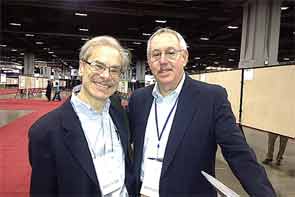Dr. Hochberg’s interest in rheumatology took shape during a nine-week elective clinical rotation as a fourth-year medical student at Johns Hopkins in 1972, when Dr. Stevens was head of the division. The first woman to chair that division, the charismatic Dr. Stevens was renowned for clinical research and treatment advances in lupus and other connective tissue diseases, and for encouraging many internists to choose rheumatology as a subspecialty. “It was largely due to the mentorship of Dr. Stevens and Dr. Shulman [that I became a rheumatologist],” said Dr. Hochberg.
At Johns Hopkins, a large patient population with systemic lupus, systemic sclerosis, rheumatoid arthritis (RA) and inflammatory muscle disease served to inform Dr. Hochberg’s concentration on the descriptive and analytic epidemiology in the connective tissue diseases. During his years as assistant professor at Hopkins, Dr. Hochberg often collaborated with Frank C. Arnett, MD, and began “exploring racial differences to try to understand the role of socioeconomic status to explain differences in development of disease as well as outcomes,” he says. This work continued in the 1980s, after the arrival of Michelle A. Petri, MD, MPH, who garnered a grant from the Hopkins General Clinical Research Center to establish the Hopkins Lupus Cohort. Dr. Hochberg worked with Dr. Petri and postdoctoral research fellows to investigate racial differences and clinical outcomes in patients with lupus.

A Shift of Research Focus
During the 1980s, Dr. Hochberg’s collaboration with postdoctoral fellow Ronenn Roubenoff, MD, MHS, blossomed into a cohort study of risk factors for gout, comparing white medical students at Hopkins with black students at Meharry Medical College. At this juncture in his career, said Dr. Hochberg, he began to shift his focus to gout and the more common arthropathies such as osteoarthritis (OA). The greater burden of disease with OA and its greater public health impact, coupled with the ability to look at environmental risk factors, were the primary reasons Dr. Hochberg was drawn to this field of study.
Another pull to OA came from Roy Altman, MD, professor emeritus, University of Miami, and professor of medicine, Division of Rheumatology and Immunology at the Ronald Reagan UCLA Medical Center, Los Angeles. At the time, Dr. Altman was involved in ACR’s development of classification criteria for OA. He recalls meeting Dr. Hochberg on a flight to the Southeast Regional Rheumatology meeting in 1981. “I think I got him interested in osteoarthritis at that time,” recalls Dr. Altman, who says that he recruited Dr. Hochberg for the OA classification criteria effort. Since that time, the two have continued to collaborate on numerous projects including recommendations for conducting clinical trials in OA for the Osteoarthritis Research Society International and management of OA. The latter recommendations were revised in 2012 under the auspices of the ACR.
